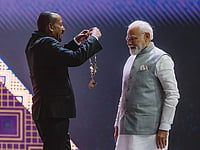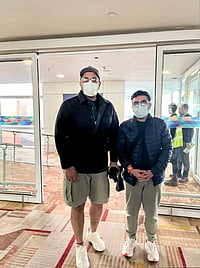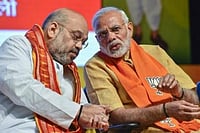This sex survey is no casual affair; it's a serious commitment. A 15-year commitment to understand the many changes on the make in the Indian Marriage Bed. To get to statistics that count not just various sexual positions at play in the conjugal chamber but also to gather data that helps compute how equations are altering between man and woman in this spousal space over the last decade-and-a-half.
No Indian sex survey has ever boasted more substantive intent or numbers: a respondent base of 15,324 people from 15 states across the country, interviewed over the 15 years between 1988 and 2003. This mammoth study was conducted by Dr D. Narayana Reddy, who has been practising and consulting on sexual medicine at his Dega Institute in Chennai and at the city's prestigious Apollo Hospitals, along with his colleague Dr Arun Kumar and a team trained in the field of sexuality.
And many myths about the sex lives of Indians are caught out and banished under such expert, and elaborate, statistical surveillance. "Our survey knocks down the popular assumption shared by the scientific fraternity and the media that we are sexually a conservative people, that our men are poor lovers and women are extremely inhibited," says Reddy, "Indians, our survey shows, are in fact, sexually very active and innovative, willing to be unconventional and experimental to seek their peaks of pleasure."
Here's the information backing this inference. The average Indian couple has sex every alternate day in their first five years of marriage, and every third day between five and 10 years of marriage. While the most adopted or preferred coital position is 'man on top' (34 per cent), 35 per cent use more than one position during a session of lovemaking. And a very large majority (83 per cent) feels that their spouses are equally enthusiastic in sex and participate actively.
Also, it's hardly the husband's prerogative to initiate sex. For a majority of couples (61 per cent), it's either spouse who starts it off, or both. And as many as 43 per cent indulge in foreplay for an average duration of 5 to 10 minutes; more than nine per cent extend it to 15 minutes or more. A significant 47 per cent of couples feel comfortable enough about their bodies to undress fully for sex; just 18 per cent want the lights off while making love.
These are remarkable figures for people from a culture that is reputedly prudish and reticent about matters sexual. And things seem to be getting better with time. Explains Reddy: "Earlier those who came into my clinic—and they were mostly men—only did so when they had sexual problems. Now, and this began in the late '90s, so many come to me to seek advice on pleasure enhancement. And it's the women today who take appointments for or bring in their husbands; they are in the lead."
Yes, the Indian woman certainly seems to have travelled huge distances, even outpaced her man, on the pleasure trail in the past fifteen years. One simple indication is the data on exposure to explicit sexual material. It has jumped nearly three and-a-half times for Indian women, from just below 10 per cent over 1988-93 to 33 per cent over 1998-2003. And then there are numbers that lend themselves to more nuanced interpretations of the Indian woman's growing appetite for pleasure. The incidence of extramarital sex, for instance, has risen 3.3 times for men in the past 15 years and 14.6 times for women in the same time span. Put another way, where one in every 130 Indian women were having, or had had, sex outside marriage over 1988-1993, the figure had leapt to one out of every nine over the last five years.
And it's telling that while the largest chunk of men who indulge in sex outside wedlock say they do so for "variety", the most common reason that women cite for physical relationships outside wedlock is the "search for sexual satisfaction". Or, the next common reason, "to get even", suggests that the husband's infidelity won't be suffered silently any more, and perhaps even met with the assertion that "I can do it too, right?"
The figures also suggest a woman is entirely aware of the power of her sexuality to help her achieve what she wants. A significant 44 per cent of the women respondents who said they had 'wandered' ticked "Others" as their reason for having sex outside marriage. While the specific reasons could be varied, as Reddy reveals: "Most of them, in personal interviews, talked of offering sex to promote their business and career prospects; their numbers have been steadily increasing over the years."
There's more that's changed in and outside the marriage bed over the years. It is interesting to look at time series data about the age of the first sexual intercourse. Over 1988-93, 21 per cent of men claimed to have had their first sex between the ages of 20 to 24. For the period 1998-2003, the figure is nearly 34 per cent, a significant rise. And the percentage of men who had to wait till 30 to really know a woman has sharply declined over these 15 years. Men are clearly having sex earlier than they were one and a half decades ago. But the numbers for women tell a different—and less clear—story. While the percentage of women having their first penetrative sexual experience as teenagers has actually declined, the percentage for 20-24 years has remained more or less the same between 1988 and 2003, and the figure for 25-29 has risen from under 31 per cent to more than 37 per cent. And at the same time, the percentage of women who had to wait till they were past thirty for their first sexual experience has dropped significantly, from 25 to 16 per cent. What does this mean? That Indian women are marrying later now than they were some years ago? While the Indian man has, over the years, started having sex earlier, on balance the Indian woman's wait to find the pleasures of the flesh seems to be getting longer. And hence, the marital clause binding on sex—the very scope of this survey—has loosened only to that extent.
At any rate, though most Indians (55 per cent) seem to be still having their first sex on the marital bed, the man-woman divide is distinct. While 46 per cent of the men were virgins at the time of marriage, the corresponding figure for women is 72 per cent. Meanwhile, close to 34 per cent of men received their first taste of sex from sex workers while 17 per cent of the women who had sex before they slept with their husbands did so with their boyfriends. But a most disturbing figure is the near ten per cent of women who had their first sex with blood relatives. As Dr Reddy explains, "Where subjects had first sexual intercourse with blood relatives, most women were forced into it."
A lot of dark spaces, then, remain in the bedroom, with the lights on or off. And the search for total compatibility and reciprocity continues. Slightly less than 50 per cent of Indian men and women have oral sex. But an overwhelming 79 per cent of the women who had oral sex said they were the sole providers of it; just 13 per cent of them said both partners did it. "Women respondents of the survey have repeatedly expressed the desire that their men give them more oral sex," says Dr Reddy, "But the men just won't oblige." In time, maybe. For, if this seminal survey on the sex lives of Indians is any indication, pleasure deferred is not necessarily pleasure heightened.
Fleshed Out
A peep into the bedroom of married couples: how, why, what they do...

Fleshed Out
Fleshed Out
Published At:
MOST POPULAR
WATCH
MORE FROM THE AUTHOR
×





















